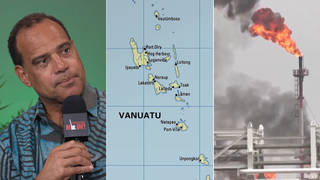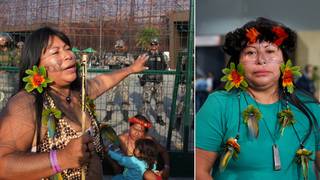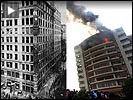
Today marks the centennial anniversary of the Triangle Shirtwaist Factory fire, the deadliest workplace accident in New York City’s history and a seminal moment for American labor. On March 25, 1911, 146 garment workers, mostly young immigrant women, died after a fire broke out at the factory. Many of them leaped to their deaths when they tried to escape and found the emergency exits locked. “I saw people throwing themselves from the window. As soon as we went down, we could not get out because the bodies were coming down” says the last survivor of the fire in a 1986 interview with Amy Goodman. Denied any collective bargaining rights, the Triangle workers were powerless to change the abysmal conditions in their factory: inadequate ventilation, lack of safety precautions and fire drills—and locked doors. [includes rush transcript]
Transcript
JUAN GONZALEZ: Today marks the centennial anniversary of the Triangle Shirtwaist Factory fire. It was the deadliest workplace accident in New York City’s history and a seminal moment for American labor. On March 25th, 1911, nearly 150 garment workers, mostly young immigrant women, died after a fire broke out at the Triangle Factory near Washington Square Park.
Only a year before the lethal fire, the garment workers of the city had protested for shorter hours, better pay, safer work conditions and the right to unionize. Tired of toiling for 13 hours a day for as little as 13 cents an hour, the workers called for a strike, emerging as leaders in what became the largest women’s labor walkout in American history. The factory owners hired thugs to suppress their action, but in the 11th week of the strike, the owners finally agreed to higher wages and shorter hours. They drew the line, however, at a union. Denied any collective bargaining rights, the Triangle workers were powerless to change the abysmal conditions in their factory: inadequate ventilation, lack of safety precautions and fire drills — and locked doors.
AMY GOODMAN: When a lit cigarette or match ignited a fire on the eighth floor of the building, flames spread quickly and trapped the women in a deadly inferno. Today we spend the hour looking back at the fire and its significance 100 years later.
We’re going to begin with an excerpt of a radio piece I produced 25 years ago, in 1986, along with Kathy Dobie. It was then the 75th anniversary of the Triangle Shirtwaist Factory fire.
PAULINE PEPE: I worked right near where the fire was. There was cutters there. They were cutting the material. And as soon as they were just going out, it was time to go home. It was 4:00 on Saturday.
AMY GOODMAN: Pauline Pepe is a 94-year-old survivor of the Triangle fire.
PAULINE PEPE: I saw the fire in the tables, where they were all full with lingerie material, you know, and that had come up in a flame. When I saw that, I ran out. I went to the door that was closed. I didn’t know that was closed. I went there, knocked on the door. Closed. I just stood there 'til they opened it. Forty people going down the steps, we all tumbling one right after another. And I saw people throwing themselves from the window. And as soon as we went down, we couldn't get out, because the bodies were coming down. It was terrible.
KATHY DOBIE: The women that died that late afternoon were young Jewish and Italian immigrants. When the fire broke out, they tried to escape down the stairs but found the doors had been locked. The owners believed that, given the chance, workers would sneak out with stolen material, and union organizers would sneak in.
AMY GOODMAN: Some of the women climbed onto the single fire escape. It collapsed. As onlookers watched, women fell nine stories to the sidewalk below. Inside the factory, the fire spread quickly, and with no exit left to them, the women climbed through the windows and leapt to their death.
While some union members walked in the vigil, others took buses to a Brooklyn cemetery, where seven unidentified Triangle victims lie buried. Union members paid their respects and read the stone marker above the women’s graves.
MONTAGE OF VOICES: “In sympathy and sorry, citizens of New York raise this monument over the grave of unidentified women and children who, with 139 others, perished by fire in the Triangle Shirtwaist Factory, Washington Place, March 25th, 1911.”
JUAN GONZALEZ: When the women realized the building was on fire, some rushed toward the open stairwell, but smoke and flames obscured their path. Hundreds of horrified onlookers watched as desperate factory workers leaped from the ninth floor windows, engulfed by flames. This is an excerpt from the new documentary Triangle Fire that aired on PBS’s American Experience. It features dramatic readings of eyewitnesses of the fire.
NARRATOR: It had been less than five minutes since the first alarm, but more than a thousand people had crowded around the Asch Building. They watched as the firemen raised their ladders to their full extension. They barely reached the sixth floor, 30 feet shy of the trapped Triangle workers.
EYEWITNESS 1: [read by Frank Pando] People began to holler, “Raise the ladders! Raise the ladders!” We had the ladders up.
WILLIAM GUNN SHEPHERD: [read by Michael Daly] One girl climbed under the window sash. Those behind her tried to hold her back. Then she dropped into space.
EYEWITNESS 2: [read by Joe Lisi] I saw groups of women embracing each other and leaping to the sidewalk. The firemen were helpless. The nets were ripped from their hands. Many stooped and picked up the nets again with their hands bleeding.
WILLIAM GUNN SHEPHERD: [read by Michael Daly] The last workers were trapped against the blackened windows, burning to death before our very eyes. The glass they were pressed against shattered. Down came the bodies in the shower, burning, smoking, flaming bodies with disheveled hair trailing upward.
EYEWITNESS 1: [read by Frank Pando] The bodies lay there on the sidewalk, three or four high, burning. And we had to play the hoses on them.
JUAN GONZALEZ: Thanks to PBS’s American Experience for footage from the film Triangle Fire, which you can watch online at pbs.org.











Media Options